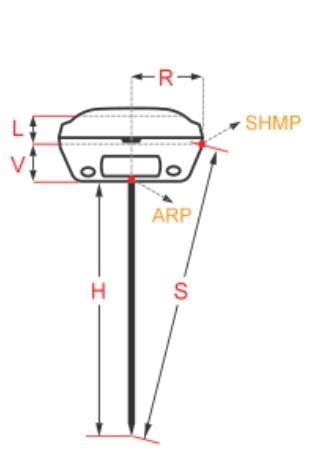What are the dist dates of: (cm)
Radio=
Midle=
Bottom=
Hi Yalexy,
I’d suggest posting a simple pic or scheme showing the distances you are requesting.

Here’s a piece. This does not include the brass adapter which is 22mm so 87mm in total.
Value H is obviously dynamic depending upon what you want to place the receiver on.
Perhaps L+V is the offset you are looking for and the ARP is the 65mm at the point between the brass adapter and the bottom of the receiver if you are using it?
I’m not sure why one would need value R unless you were trying to manufacture something. In that case the specs may help.
S = do not use
R = do not use (zero)
V = 134mm
H = variable (you measure yourself)
L = ???
edit: I think V + L = 134mm. So it might make the best sense for V = 0 and L = 134mm
I Think thas R=71.50mm
V=31 mm
L=53 mm
but I am not shure:cry:![]()
![]()
http://gphandlahdpffmccakmbngmbjnjiiahp/https://docs.emlid.com/reachrs/files/reachrs-drawing.pdf
Sure, but with all those fancy measurements and letter symbols, all they point to in the end is:
How high is my GNSS antenna over the point I am over top of?
For us that usually means, measure the pole and add the 134mm. That is it.
It was explained in an earlier topic that the reason that GPS field technicians used to measure slope height (S) is because the old antennas had a large radius (R). It was more convenient/accurate for them to take the indirect measurement (slope height) at the edge of the antenna, and then use trigonometry with the remaining constant values (V,R) to calculate the pole height (H) over the point and then derive antenna height by adding (H+V+L).
Why would you go through all that if your pole is 2m and the internal antenna height is 134mm? 2m + 134mm = 2.134mm
These days with small diameter antennas It is so much easier to do it the simple way.
This topic was automatically closed 100 days after the last reply. New replies are no longer allowed.



